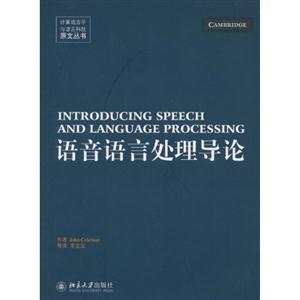語音語言處理導論-含CD-ROM1張 版權信息
- ISBN:9787301171530
- 條形碼:9787301171530 ; 978-7-301-17153-0
- 裝幀:暫無
- 冊數:暫無
- 重量:暫無
- 所屬分類:>
語音語言處理導論-含CD-ROM1張 本書特色
《語音語言處理導論》:計算語言學與語言科技原文叢書
語音語言處理導論-含CD-ROM1張 目錄
導讀Acknowledgements and copyright notices1 Introduction1.1 About this book1.2 Purpose of this book1.3 Some reasons to use this book1.4 What's in the book (and what's not)1.5 Computational set-up needed for this book1.6 Computational skills that are necessary in order to use the book1.7 Free software suggestions1.8 Book structureSounds and numbers2.1 Preparatory assignments2.2 Solutions2.3 Sampling2.4 Quantization2.5 The sampling theorem2.6 Generating a signal2.7 Numeric data types2.8 The program2.9 Structure of a loop2.10 Structure of an array2.11 Calculating the cosine values2.12 Structure of the program2.13 Writing the signal to a fileChapter summaryFurther ExercisesFurther readingDigital filters and resonators3.1 Operations on sequences of numbers3.2 A program for calculating RMS amplitude3.3 Filtering3.4 A program for calculating running means of 43.5 Smoothing over a longer time-window3.6 Avoiding the need for long window 3.7 IIR filters in C3.8 Structure of the Klatt formant synthesizerChapter summaryExercisesFurther reading Frequency analysis and linear predictive coding4.1 Spectral analysis4.2 Spectral analysis in C4.3 Cepstral analysis4.4 Computation of the cepstrum in C4.5 Pitch tracking using cepstral analysis4.6 Voicing detection4.7 f0estimation by the autocorrelation method4.8 Linear predictive coding4.9 C programs for LPC analysis and resynthesis4.10 Trying it out4.11 Applications of LPCChapter SummaryFurther exercisesFurther readingFinite-state machines5. 1 Some simple examples5.2 A more serious example5.3 Deterministic and non-deterministic automata5.4 Implementation in Prolog5.5 Prolog's processing strategy and the treatmentof variables5.6 Generating strings5.7 Three possibly useful applications o{ that idea5.8 Another approach to describing finite-state machines5.9 Self-loops5.10 Finite-state transducers(FSTs)5.11 Using finite-state transducers to relate speech to phonemes5.12 Finite-state phonology5.13 Finite-state syntactic processingChapter summaryFurther exercisesFurther readingIntroduction to speech recognition techniques6.1 Architectures for speech recognition6.2 The pattern-recognition approach6.3 Dynamic time warping6.4 Applications6.5 Sources of variability in speechChapter summaryFurther readingProbabilistic finite-state models7.1 Introduction7.2 Indeterminacy: n-gram models for part-of-speech tagging ~7.3 Some probability theory for language modelling7.4 Markov models7.5 Trigram models7.6 Incompleteness of the training corpus7.7 Part-of-speech model calculations7.8 Using HMMs for speech recognition7.9 Chomsky's objections to Markov models and some rejoindersChapter summaryFurther readingParsing8.1 Introduction8.9 A demo8.3 Intuitive parsing8.4 Recursive descent parsing8.5 The simplest parsing program8.6 Difference lists8.7 Generating a parse tree8.8 Syllabification8.9 Other parsing algorithms8.10 Chart parsing8.11 Depth-first vs. breadth-first search8.19 Deterministic parsing, Marcus parsing and minimal commitment parsing8.13 Parallel parsingChapter summaryFurther readingUsing probabilistie grammars9.1 Motivations9.2 Probabilistic context-free grammars9.3 Estimation of rule probabilities9.4 A practical example9.5 A limitation of probabilistic context-free grammars9.6 Tree adjoining grammars……
展開全部
語音語言處理導論-含CD-ROM1張 節選
《語音語言處理導論》主要內容簡介:中國國內中俄翻譯研究也不遑多讓,大約在上世紀50年代中期便已開始。可惜的是,這些中文相關早期機器翻譯研究,由于硬件與軟件的限制,沒能延續下來。中文計算語言學研究比較有系統的進展,還要等到1986年;海峽兩岸在同一年成立了兩個致力于中文計算語言學基礎架構建立的研究群。北京大學的計算語言學研究所在朱德熙先生倡導下成立,隨后一段時間由陸儉明、俞士汶主持。而臺灣“中研院”的中文詞知識庫小組,由謝清俊創立,陳克健主持,黃居仁1987年返臺后加入。
語音語言處理導論-含CD-ROM1張 相關資料
插圖:語音和語言處理都以人類語言為處理對象,但處理的層面卻不相同。語音處理關注的是利用計算機對語音信號進行分析和綜合,從而實現合成和識別人類語音。而語言處理更多關注對人類語言的句法、語義進行建模,終極目標是實現人類語言的機器理解。盡管語音處理和語言處理的對象都是人類語言,不過傳統上這是兩個相互獨立的學科,這兩個領域的研究和教學也是獨立進行的,教科書內容通常也不交叉。不過近年來,隨著這兩個學科的進一步發展,它們之間的關系變得日益密切,兩個學科之間的聯系越來越受到人們的重視。人們越來越意識到,對于語言理解而言,語音特征絕非沒有價值。反過來,語音處理研究也需要關注語言處理的進展,將語言處理的成果應用到語音識別和語音合成研究,有利于提升語音處理的性能。此外,這兩個學科在方法論方面也有共性,相互影響和借鑒的情況也時有發生。例如,在20世紀80年代,隱馬爾可夫模型被用來解決詞性自動標注問題,就是受到該模型應用在語音識別研究中獲得成功的啟發,尤其值得一提的是,隱馬爾可夫模型引入語言處理領域所產生的影響決不是局部性的,它帶動了以語料庫為基礎的經驗主義方法在語言處理領域的全面復蘇,有著十分重要的意義。這些事例說明,語音和語言處理正在日趨交叉和融合,未來的相關研究和開發需要對這兩個領域都有相當理解和把握的人才。
語音語言處理導論-含CD-ROM1張 作者簡介
作者:(美國)克勒曼(John Coleman) 合著者:常寶寶















